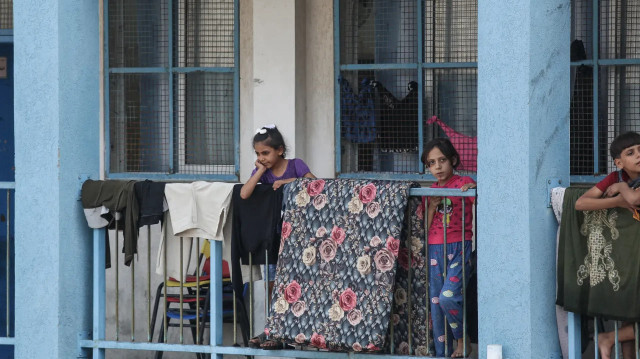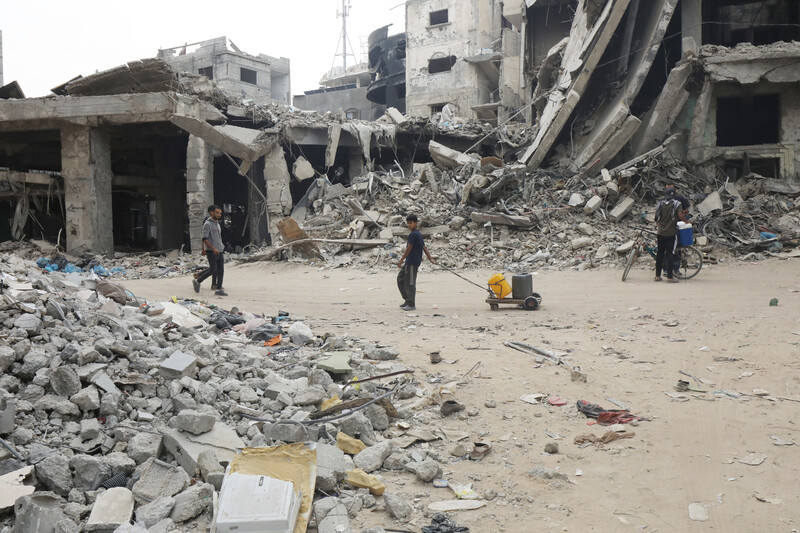Over 16,000 people are living in 1 school in central Gaza: UN refugee agency
More than 32,000 people have also fled Rafah in the past two days, says UNRWA
30/05/2024 Thursday
AA

The UN Agency for Palestinian Refugees (UNWRA) said Thursday that more than 16,000 displaced Palestinians are living in dire conditions in one of its schools in Deir al-Balah city in central Gaza.
The agency shared an image of the school on X.
“Families are living in classrooms, hallways and makeshift shelters built with plastic,” it said.
The agency described living conditions in the school as dire with scarce resources, insufficient sanitation facilities and very limited supplies.
UNRWA also revealed that in the past two days, more than 32,000 people have fled the city of Rafah in southern Gaza.
“Families look for safety, but damage and destruction are their only horizon in the Gaza Strip,” it added.
“No place is safe from endless bombardment,” UNRWA said, highlighting the pervasive danger faced by civilians.
“People forced to leave everything behind; their lives at risk every day,” it added.
The Israeli army began its ground offensive on Rafah on May 6. Around 1.5 million displaced Palestinians had sought refuge there, with UNRWA saying that more than 800,000 have fled the city since the start of the attack.
Rafah's vital border crossing with Egypt has been closed since Israel seized the Gazan side when it began its Rafah invasion.
Israel has continued its brutal offensive on Gaza following an attack by the Palestinian group Hamas on Oct. 7 last year, despite a UN Security Council resolution demanding an immediate cease-fire.
More than 36,240 Palestinians have since been killed in Gaza, the vast majority being women and children, and over 81,777 others injured, according to local health authorities.
Nearly eight months into the Israeli war, vast swathes of Gaza lay in ruins amid a crippling blockade of food, clean water and medicine.
Israel stands accused of genocide at the International Court of Justice (ICJ), which in its latest ruling ordered it to immediately halt its operation in Rafah.
Returning to find a city filled with rubble
Ruwaida Amer The Electronic Intifada 31 May 2024

Fetching water is an arduous task in Khan Younis. Naaman OmarAPA images
Massive destruction has been inflicted on Khan Younis in southern Gaza.
The city’s residents were forced to flee en masse when Israeli troops invaded in December. The ground offensive lasted several months.
When people returned, they were shocked to see what remained. Many areas of the city were almost unrecognizable.
People either had to set up tents where they used to live or try to reclaim part of homes that had been damaged – often badly – and move back in.
Khaled al-Sir, 50, had to evacuate his home in the center of Khan Younis during January. He went to the outskirts of the city and sought basic shelter in a tent.
It offered no real protection from the elements.
“I kept on getting sick during the winter months,” he said. “When temperatures began to rise, it was as hot as hell inside the tent.”
After he heard that Israeli troops had withdrawn from Khan Younis, Khaled returned to inspect his house.
It had been struck by shells and largely destroyed. Yet Khaled said he decided to move back in “without hesitation.”
Despite being told that Israel had laid waste to the city’s infrastructure, Khaled felt “it would be better to spend all day searching for water than to return to the tent.”
“I was happy to see neighbors and friends again,” he added. “I felt that my soul had been given back to me.”
Bulldozed
Marwa al-Louh, 40, lived behind Nasser Medical Complex in Khan Younis.
“The Israeli army completely bulldozed my home,” she said. “There is no trace of it.”
Marwa had evacuated Khan Younis and gone to an area near Rafah, Gaza’s southernmost city. When Israel invaded Rafah a few weeks ago, she came back to Khan Younis.
“I cried a lot when I found that my home was a pile of rubble,” she said. “But I did not despair and set up a tent where my house used to be.”
Her daily routine now includes joining a long queue for water.
Although she takes some comfort in being reunited with neighbors, she said that “it is difficult to live in a city filled only with rubble.”
“The situation here is very depressing,” she added.
Salem Daqqa, 28, had been displaced from Abasan, east of Khan Younis. When he returned a few weeks ago, he encountered total destruction.
It is impossible for farmers in the area to work as it is close to the boundary with Israel. The Israeli military has a tendency to open fire at anyone approaching the boundary.
Even though Israel has removed ground troops from the area, its airstrikes against Abasan are continuing. Several members of one family were killed in one such airstrike recently.
“We are tired of being displaced,” Salem said. “We have decided to return home, even though there is still a big danger.”
Salem previously worked selling vegetables – grown by local farmers – on Jalal street in Khan Younis. He had a stall near the Bank of Palestine.
“When we went back to the city, I was shocked by what I saw on the street,” he said.
“The shops and the banks were completely destroyed – as if there had been an earthquake in the area or a nuclear bomb was dropped on the street.”
Ruwaida Amer is a journalist based in Gaza.
Gaza's Jabalia camp left in ruins after Israeli army withdrawal
Israeli forces withdrew from northern Gaza on Friday, leaving behind large-scale destruction of homes and infrastructure.
The New Arab Staff
31 May, 2024

Jabalia camp has been under intense bombardment since 8 October [Getty]
The Israeli army withdrew from Gaza's Jabalia camp on Friday after a 20-day bombardment that destroyed homes and infrastructure.
Jabalia is Gaza’s largest refugee camp, once home to over 100,000 people.
Several bodies have been recovered from the camp and the nearby Beit Lahia area, according to the Palestinian Red Crescent Society.
The organisation says its teams are facing difficulties extracting bodies from under the rubble due to a lack of the necessary equipment, and the delayed recovery poses a risk of diseases and epidemics in north Gaza.
Palestinians have been forced to search through the rubble, trying to find their belongings and loved ones.
The Israeli army said on Friday its troops had "completed" its mission in eastern Jabalia and is preparing for new incursions.
The military claimed it had killed hundreds of fighters, recovered the bodies of seven Israeli captives and destroyed 10km of underground tunnels.
Palestinians in Rafah struggle to figure out where to go
The Israeli army started the operation on 12 May, stating they were on a mission to locate Hamas cells. The attacks forced thousands to flee towards the west of Gaza City.
Over 70 percent of the camp has been destroyed, including public facilities, hospitals and schools.
Al Jazeera reported over 1,0000 homes have been destroyed, while residential buildings were also burned down.
In southern Gaza, Israeli forces continued their bombardment of Rafah, where hundreds of thousands of forcibly displaced Palestinians are sheltering, with no other area to flee to.
World leaders expressed outrage over an Israeli strike on 26 May which targeted a displacement camp, killing 45 civilians, despite the International Court of Justice (ICJ) ordering an "immediate halt" to the invasion.
Since 7 October, over 36,200 Palestinians have been killed in Gaza, while at least 81,800 have been wounded. At least 10,000 more are either missing or under the rubble.
Israeli forces withdrew from northern Gaza on Friday, leaving behind large-scale destruction of homes and infrastructure.
The New Arab Staff
31 May, 2024

Jabalia camp has been under intense bombardment since 8 October [Getty]
The Israeli army withdrew from Gaza's Jabalia camp on Friday after a 20-day bombardment that destroyed homes and infrastructure.
Jabalia is Gaza’s largest refugee camp, once home to over 100,000 people.
Several bodies have been recovered from the camp and the nearby Beit Lahia area, according to the Palestinian Red Crescent Society.
The organisation says its teams are facing difficulties extracting bodies from under the rubble due to a lack of the necessary equipment, and the delayed recovery poses a risk of diseases and epidemics in north Gaza.
Palestinians have been forced to search through the rubble, trying to find their belongings and loved ones.
The Israeli army said on Friday its troops had "completed" its mission in eastern Jabalia and is preparing for new incursions.
The military claimed it had killed hundreds of fighters, recovered the bodies of seven Israeli captives and destroyed 10km of underground tunnels.
Palestinians in Rafah struggle to figure out where to go
The Israeli army started the operation on 12 May, stating they were on a mission to locate Hamas cells. The attacks forced thousands to flee towards the west of Gaza City.
Over 70 percent of the camp has been destroyed, including public facilities, hospitals and schools.
Al Jazeera reported over 1,0000 homes have been destroyed, while residential buildings were also burned down.
In southern Gaza, Israeli forces continued their bombardment of Rafah, where hundreds of thousands of forcibly displaced Palestinians are sheltering, with no other area to flee to.
World leaders expressed outrage over an Israeli strike on 26 May which targeted a displacement camp, killing 45 civilians, despite the International Court of Justice (ICJ) ordering an "immediate halt" to the invasion.
Since 7 October, over 36,200 Palestinians have been killed in Gaza, while at least 81,800 have been wounded. At least 10,000 more are either missing or under the rubble.
No comments:
Post a Comment